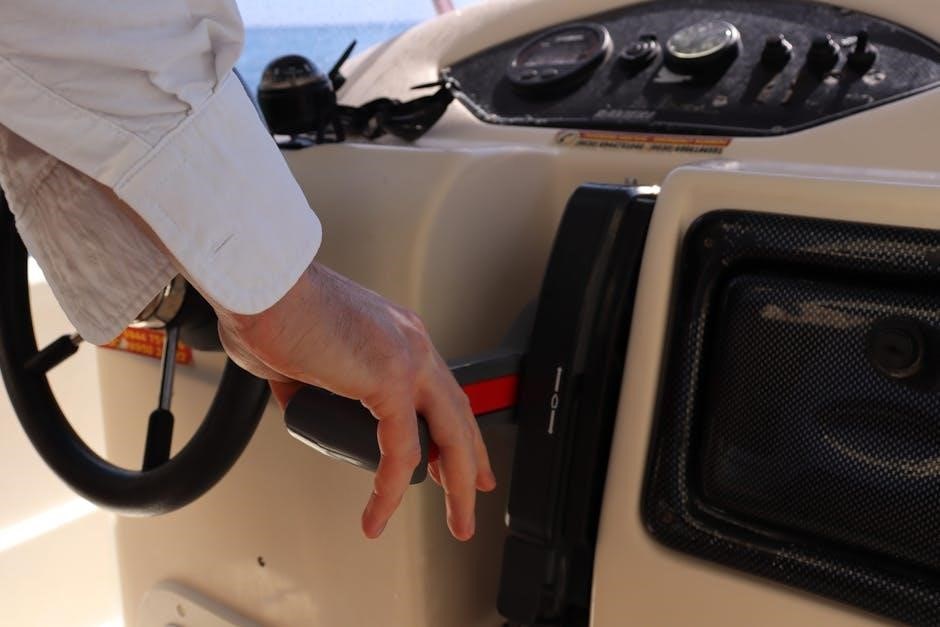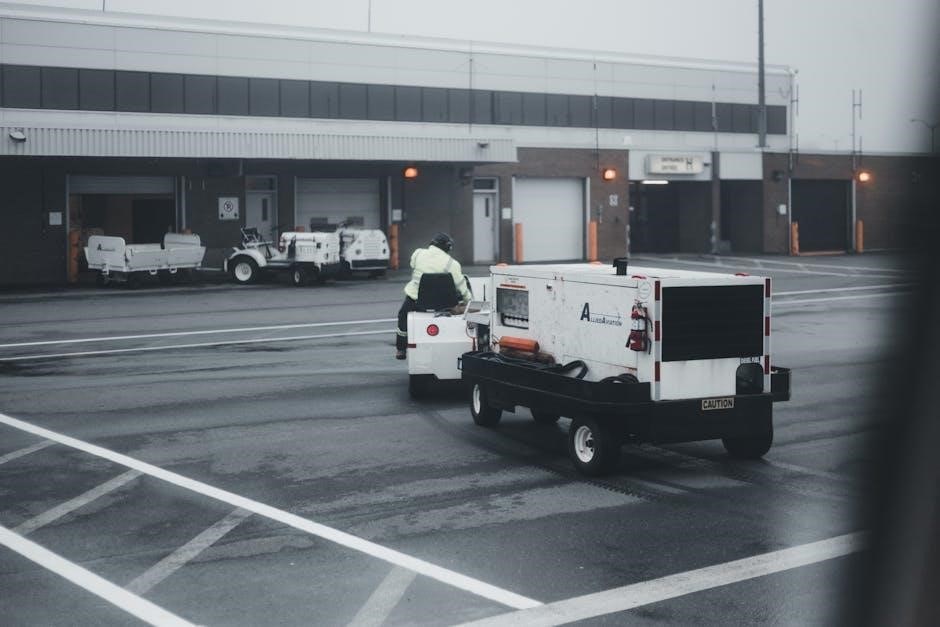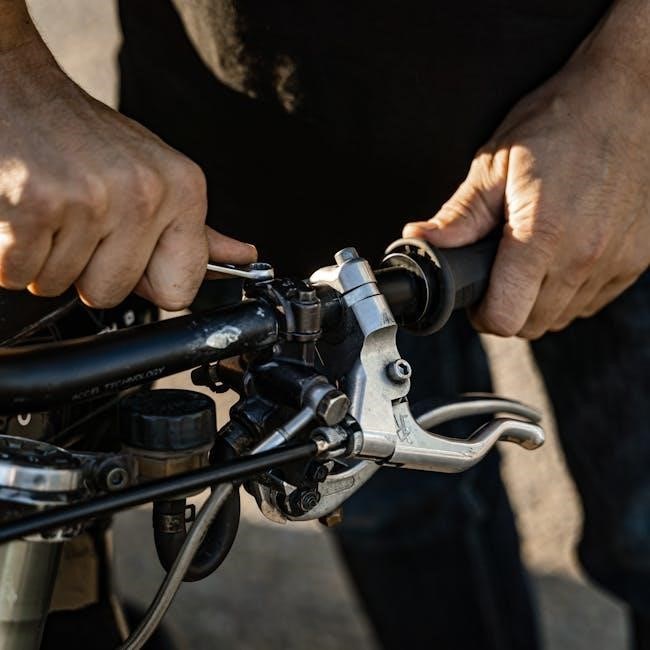Welcome to the Reese Trailer Brake Controller Manual, your essential guide for safe and efficient towing. This manual provides detailed instructions for installation, operation, and troubleshooting, ensuring optimal performance and control of your trailer brakes. Designed to enhance towing safety, it offers comprehensive insights for both novice and experienced users.
1.1 Purpose and Importance of the Manual
The Reese Trailer Brake Controller Manual serves as a vital resource for ensuring safe and effective towing experiences. Its primary purpose is to provide detailed instructions for installing, operating, and maintaining the brake controller. This guide is essential for understanding how to properly connect and calibrate the system, ensuring optimal braking performance. By following the manual, users can avoid common issues and troubleshoot problems efficiently. It emphasizes safety, offering clear guidelines to prevent accidents and maintain control while towing. Whether you’re a novice or an experienced tower, this manual is indispensable for maximizing the reliability and functionality of your Reese Trailer Brake Controller. It covers error codes, wiring diagrams, and maintenance tips, making it a comprehensive tool for every user.
The manual’s importance lies in its ability to empower users with knowledge, ensuring their trailer braking system operates flawlessly in all conditions.
1.2 Overview of Reese Trailer Brake Controllers
Reese Trailer Brake Controllers are reliable and versatile systems designed to enhance towing safety and control. They are compatible with trailers ranging from 1 to 4 axles, offering precise braking solutions tailored to different trailer weights. These controllers feature both proportional and user-adjustable settings, ensuring smooth braking under various conditions. The manual override function provides immediate control in emergencies, while advanced error detection helps identify issues quickly. Reese controllers are known for their durability and ease of use, making them a popular choice among tow vehicle owners. With comprehensive support through their manuals, users can easily install, troubleshoot, and maintain their brake controllers, ensuring optimal performance and safety on the road. This overview highlights the key features and benefits that make Reese Trailer Brake Controllers a trusted choice for towing enthusiasts.

Installation Guidelines
Proper installation of your Reese Trailer Brake Controller ensures safe and effective operation. Follow the step-by-step guide, wiring diagrams, and connection instructions for a secure setup.
2.1 Step-by-Step Installation Process
The installation of the Reese Trailer Brake Controller involves several key steps. First, locate a suitable mounting position inside your vehicle, ensuring easy access to the controls. Next, connect the power wire to the battery, the ground wire to a metal surface, and the brake switch wire to the vehicle’s brake pedal circuit. Then, install the trailer plug and connect the appropriate wires according to the wiring diagram provided in the manual. Finally, calibrate the controller by adjusting the gain and output settings to match your trailer’s specifications. This process ensures a safe and efficient towing experience. Always refer to the manual for specific instructions tailored to your vehicle and trailer setup.
2.2 Wiring Diagram and Connections
The wiring diagram in the Reese Trailer Brake Controller Manual outlines the connections needed for proper installation. Begin by connecting the 12V power wire directly to the vehicle’s battery, ensuring a constant power supply. Next, attach the ground wire to a clean, bare metal surface to complete the circuit. The brake switch wire connects to the vehicle’s brake pedal circuit, activating the trailer brakes when the vehicle brakes are applied. Additionally, connect the trailer plug wires according to the diagram, typically including the brake, tail, and turn signal lights. For manual override functionality, ensure the appropriate wire is connected to the controller. Refer to the wiring diagram for specific pin assignments and connections. Proper wiring ensures safe and reliable operation of the trailer brakes. Always consult the manual for detailed instructions tailored to your vehicle and trailer setup.

Operating the Reese Trailer Brake Controller
Operating the Reese Trailer Brake Controller involves adjusting settings, monitoring trailer weight, and using manual override during towing. The interface provides real-time feedback for precise control.
3.1 Understanding the Controls and Features
The Reese Trailer Brake Controller features a user-friendly interface with a digital display, adjustment knobs, and a manual override button. The display shows real-time brake activity, while the knobs adjust braking sensitivity and trailer weight settings. The manual override allows for instant braking in emergencies. Additional features include a built-in sensor for proportional braking, automatic level adjustment, and a boost function for heavier trailers. The controller also has customizable settings to suit different towing conditions. Understanding these controls ensures safe and effective trailer braking performance. Proper adjustment of settings is crucial for balanced braking and preventing trailer sway. Familiarizing yourself with these features enhances towing safety and control.
3.2 Manual Override and Emergency Braking
The Reese Trailer Brake Controller includes a manual override feature for emergency braking situations. This function allows the driver to apply the trailer brakes independently of the vehicle’s brakes, ensuring immediate stopping power. In emergencies, pressing the manual override button engages the trailer brakes firmly, helping to maintain control and prevent accidents. The system is designed to provide consistent braking pressure, even in panic situations. It is crucial to use the manual override judiciously, as abrupt braking can lead to trailer sway or loss of vehicle control. Always ensure the trailer is properly loaded and the brake controller is calibrated for safe emergency braking performance. Regular testing of the manual override function is recommended to ensure reliability. This feature enhances safety and driver confidence during towing operations.

Troubleshooting Common Issues
This section helps identify and resolve common problems with the Reese Trailer Brake Controller, such as error codes, wiring issues, or uneven brake performance, ensuring proper function.
4.1 Identifying Error Codes and Their Meanings
Understanding error codes is crucial for diagnosing issues with the Reese Trailer Brake Controller. Common codes include E1 for sensor malfunctions, E2 for wiring issues, and E3 for communication faults. Each code corresponds to specific problems, such as faulty brake sensors, disconnected wires, or mismatches in trailer settings. Referencing the manual’s error code chart helps pinpoint the exact issue. For example, E1 may indicate a faulty accelerometer, while E2 could signal a short circuit or corroded connections. Always consult the manual or contact customer support if unsure. Regular checks and proper maintenance can prevent many of these errors, ensuring safe and reliable braking performance.
4.2 Diagnosing Brake Controller Malfunctions
When diagnosing issues with the Reese Trailer Brake Controller, inspect wiring connections for damage or corrosion. Ensure the power supply is stable and within the recommended voltage range. Test components like brake sensors and the accelerometer to confirm functionality. If error codes appear, refer to the manual for their meanings. Use a multimeter to check for shorts or open circuits in the wiring harness. Perform a manual override test to isolate the issue. If unresolved, consult the troubleshooting guide or contact technical support. Regular maintenance, including cleaning connections and software updates, helps prevent malfunctions and ensures reliable braking performance. Always follow safety guidelines when testing electrical systems properly.

4;3 Advanced Troubleshooting Techniques
For complex issues, advanced troubleshooting techniques involve system resets, software updates, and detailed electrical checks. Reset the controller by disconnecting the battery for 10 minutes to clear internal faults. Update the software to the latest version using the manufacturer’s guidelines. Use a multimeter to test resistance and continuity in the brake circuit. Perform a logic test to ensure the controller responds to acceleration and braking inputs. Isolate the issue by testing individual components, such as the brake magnet or wiring harness. If problems persist, consult the manual or contact Reese’s technical support for specialized assistance. Always follow safety protocols when working with electrical systems to avoid further damage or safety risks. Advanced troubleshooting requires precision and attention to detail to resolve intricate malfunctions effectively. Regular updates and thorough checks help maintain optimal performance and reliability.

Maintenance and Upkeep
Regular inspections of wiring and connections ensure optimal performance. Clean the controller and connectors to prevent dirt buildup. Check brake fluid levels and pad condition for proper braking. Follow manufacturer recommendations for periodic maintenance to extend the lifespan of the system and ensure reliable operation during towing. Always store the controller in a dry, protected area to prevent damage. Regular upkeep helps maintain safety and efficiency while minimizing the risk of unexpected malfunctions on the road. Consistent care ensures the Reese trailer brake controller functions at its best for years to come. Routine checks and timely replacements are essential for hassle-free towing experiences. Proper maintenance also enhances the overall durability of the braking system.
5.1 Routine Checks for Optimal Performance
Regular checks are essential to ensure the Reese trailer brake controller operates effectively. Start by inspecting the wiring and connections for damage or corrosion. Verify that all electrical connections are secure and free of debris. Check the brake fluid levels in the towing vehicle to ensure proper hydraulic pressure. Inspect the brake pads and rotors for wear, as uneven wear can affect braking performance. Test the controller’s manual override function to ensure it engages smoothly. Clean the electrical connectors with a soft brush or cloth to prevent interference. Finally, review the manufacturer’s recommendations for any specific maintenance intervals. These routine checks help prevent issues, ensuring safe and reliable braking during towing. Consistent monitoring also extends the lifespan of the system. Always address any discrepancies promptly to maintain optimal performance. Regular inspections are key to hassle-free towing experiences.
5.2 Cleaning and Replacing Components
Cleaning and replacing components of the Reese trailer brake controller is crucial for maintaining its functionality. Begin by gently cleaning the electrical connectors with a soft brush or compressed air to remove dirt and corrosion. Inspect the wiring harness for signs of wear or damage; replace any frayed or exposed wires immediately. Brake pads and shoes should be checked for excessive wear and replaced if necessary. If the controller’s sensors or solenoid malfunction, refer to the manual for replacement procedures. Always use genuine Reese parts to ensure compatibility and performance. After replacing any component, test the system thoroughly to confirm proper operation. Regular cleaning and timely replacements prevent sudden failures and ensure reliable braking performance during towing. Always follow safety guidelines when working with electrical and braking systems. Proper maintenance extends the lifespan of the controller and enhances towing safety.

Safety Tips and Best Practices
Always ensure proper brake system maintenance, follow weight guidelines, and secure the trailer firmly. Conduct pre-trip inspections and practice towing in open, safe areas to build confidence.
6.1 Ensuring Safe Towing Conditions
To ensure safe towing conditions, always inspect the trailer and vehicle before each trip. Verify that the Reese Trailer Brake Controller is properly installed and configured. Check the trailer brakes, tires, and coupler for wear or damage. Ensure the trailer is loaded evenly and within weight limits. Secure all cargo tightly to prevent shifting during transit. Use safety chains and connect the trailer brakes to the vehicle’s braking system correctly. Test the brakes on a flat surface before driving. Adjust the brake controller settings as needed for smooth braking. Always maintain a safe following distance and be aware of road conditions. Regularly inspect wiring and connections to prevent malfunctions. Follow all local towing regulations and guidelines for a safe towing experience.
6.2 Pre-Trip Inspections and Checks

Before every trip, conduct a thorough pre-trip inspection to ensure the Reese Trailer Brake Controller and trailer are in optimal condition. Start by verifying the controller’s settings and ensuring it is properly synchronized with the trailer brakes. Check the trailer’s electrical connections, including the plug and wiring, for damage or corrosion. Inspect the brake pads, drums, and rotors for wear. Ensure the trailer tires are inflated to the recommended pressure and show no signs of damage. Test the trailer lights, including brake lights and turn signals, to confirm they are functioning correctly. Examine the hitch and coupler for proper alignment and security. Finally, perform a test drive in a safe area to ensure the brakes engage smoothly and the trailer responds to inputs. Regular pre-trip checks help prevent issues and ensure a safe journey.

Product Features and Specifications
The Reese Trailer Brake Controller offers advanced features like digital display, proportional braking, and compatibility with multiple trailer types. It supports up to four axles, ensuring precise control and smooth stops. The compact design allows easy installation, while its automatic leveling feature enhances convenience. Safety is prioritized with manual override and real-time monitoring capabilities. This controller is built for durability and reliability, making it a top choice for towing needs.
7.1 Key Features of the Reese Trailer Brake Controller
The Reese Trailer Brake Controller is equipped with a range of innovative features designed to enhance towing safety and efficiency. Its proportional braking system ensures smooth, synchronized stopping by adjusting brake force based on the tow vehicle’s deceleration. The digital display provides clear, real-time feedback on braking activity and system status. Compatible with up to four axle trailers, this controller offers versatility for various towing needs. It also features a manual override function for emergency braking situations, giving drivers greater control. The compact, durable design ensures long-term reliability, while the automatic leveling capability simplifies installation and operation. Customizable settings allow users to fine-tune brake sensitivity, ensuring optimal performance for different trailer weights and driving conditions. These features combine to make the Reese Trailer Brake Controller a reliable and user-friendly solution for safe towing experiences.
7.2 Compatibility with Different Trailer Types
The Reese Trailer Brake Controller is designed to work seamlessly with a variety of trailer types, ensuring versatility for diverse towing needs. It is compatible with standard electric brake systems, as well as gooseneck and fifth-wheel trailers, making it a versatile choice for both recreational and heavy-duty applications. The controller supports trailers with up to four axles, accommodating everything from small utility trailers to large RVs. Its universal design allows it to integrate with most electric over hydraulic brake systems, commonly used in boat trailers. Additionally, the controller is compatible with trailers equipped with anti-lock braking systems (ABS), ensuring enhanced safety and control. This broad compatibility makes the Reese Trailer Brake Controller a practical solution for towing enthusiasts and professionals alike, regardless of their trailer type or braking system configuration.

Comparison with Other Brake Controllers
The Reese Trailer Brake Controller stands out for its ease of installation, advanced features, and durability. It offers superior braking control compared to competitors, ensuring smoother towing experiences.
8.1 Advantages Over Competitive Products
The Reese Trailer Brake Controller offers several advantages over competitive products. Its user-friendly interface and intuitive design make installation and operation straightforward, even for novice users; The controller provides precise control over trailer brakes, ensuring smooth and safe towing experiences. Additionally, it features advanced synchronization with the vehicle’s braking system, reducing stopping distances and enhancing overall safety. Reese controllers are also known for their durability and reliability, with robust construction that withstands harsh towing conditions. Furthermore, they are compatible with a wide range of trailer types and sizes, offering versatility for different towing needs. Compared to other brands, Reese controllers often come with enhanced safety features and better customer support, making them a preferred choice among towing enthusiasts.
8.2 Unique Selling Points
The Reese Trailer Brake Controller is distinguished by its advanced proportional braking system, which ensures smooth and controlled stopping by applying brake pressure in proportion to the vehicle’s deceleration. This feature enhances towing stability and safety. Additionally, the controller boasts a compact, ergonomic design that fits seamlessly into most vehicle interiors. Its digital display provides clear, real-time feedback on brake activity and system status, making it user-friendly. The controller also offers customizable braking settings, allowing users to adjust sensitivity based on trailer weight and driving conditions. Furthermore, Reese controllers are known for their robust construction and weather-resistant components, ensuring reliability in harsh environments. These unique features make the Reese Trailer Brake Controller a standout option for drivers seeking precision, durability, and ease of use.